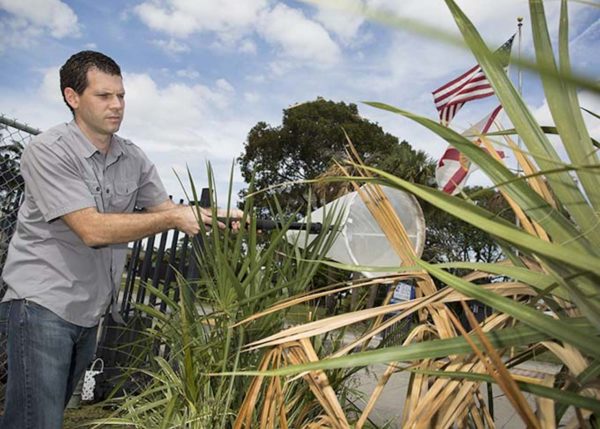A University of Florida scientist has published an in-depth look at the insect responsible for infecting more than a dozen species of palm trees worldwide, including the official state tree, with a deadly disease known as lethal bronzing.
Homeowners, nursery managers, arborists and landscapers now have access to the first of what will be many resources to help identify, monitor and manage the pest and disease, which has had significant economic and aesthetic impacts to 19 palm tree species. “American palm cixiid haplaxius crudus van duzee (insecta: hemiptera: cixiidae)” made its debut this month on Ask IFAS, UF/IFAS’ Electronic Data Information Source (EDIS) peer-reviewed site.
“This first in a series of publications is an update that focuses on the insect causing the disease,” said Brian Bahder, an assistant professor at UF/IFAS Fort Lauderdale Research and Education Center.
Bahder has been leading a team of researchers studying the disease and insect. “The publication, designed for residents and industry professionals lays the foundation for identifying, monitoring and managing the vector. As we continue to learn more about this insect, we will continue to give recommendations for how to control and how to identify it in different habitats.”
Bahder has witnessed the steady decline of palm trees throughout Florida.

The article provides a detailed description of the adult Haplaxius crudus (H. crudus) insect giving consumers a birds-eye view for identification purposes, the insect’s life cycle, the range of palm species currently reported as vulnerable to the disease and the economic impact of the insect to the industry.
One of the key takeaways to helping manage and monitor the continued spread of the species and disease is the need for consumers and professionals to sample for H. crudus.

“We have come a long way in understanding the epidemiology of this disease, and now that we know what insect is responsible for spreading it, we can start to control it,” said Bahder.
Among key research takeaways:
- The current management of disease relies on tree removal and antibiotics, neither of which are sustainable, thus managing the insect will be the way to control the disease.
- The first line of defense is knowing where your insect (vector) is and when it is most abundant so you can implement management options.
- Identifying the insect vector is also critical; incorrect identification can result in unnecessary economic losses.
“The next phase is to optimize trapping and monitoring programs and establish different population trends in different areas of the state,” Bahder said. “We will also need to determine what insecticides will be effective and to start looking into cultural practice and non-insecticide options that may help manage vector populations both in nurseries and urban habitat.”
The Palm Phytoplasma Diagnostic Clinic at the UF/IFAS Fort Lauderdale Research and Education Center can process yellow sticky traps to determine presence of H. crudus and determine if the local population carries the disease. Sample submission forms and instructions can be found at www.bahderlab.com under the “Services” tab.
Research has identified 19 palm tree species vulnerable to the disease. Species like our state tree — known as the sabal or cabbage palm, along with the silver date palms and the queen palms are just three of the species found to be vulnerable to the bacteria known as phytoplasma. The bacteria spreads by the H. crudus feeding on the tree.
While the insects are native to Florida and the Caribbean, only a small percentage of them, — less than 1 percent of this disease infecting population — are found to have the phytoplasma that infects the trees.
South Florida is home to a vast diversity of palm tree species. The disease spreads when the insect moves from one tree to another and injects infected saliva in the healthy plant.
The most important takeaway for consumers to note is that once symptoms show up on the palm tree, it is too late, which is why prevention is the first line of defense, Bahder said.
“This research stands to reduce negative economic impacts in Florida, as well as in any state or country that is suffering losses due to palm phytoplasma infections,” he said.

